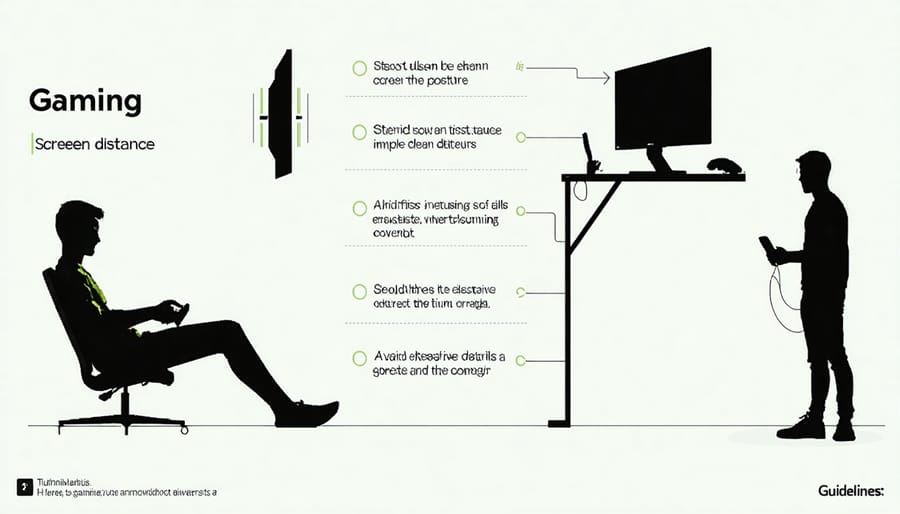In today’s digital age, the relationship between video games and youth development has become a crucial concern for parents and educators. While media’s influence on children continues to evolve, research reveals both promising benefits and legitimate concerns about gaming’s impact on young minds. From enhanced problem-solving abilities and improved hand-eye coordination to potential risks of addiction and decreased physical activity, video games present a complex dynamic that demands thoughtful consideration.
As parents navigate this digital landscape, understanding gaming’s multifaceted effects becomes essential for making informed decisions about their children’s screen time. Recent studies show that moderate, supervised gaming can actually support cognitive development and social skills, while excessive use may interfere with academic performance and emotional well-being. This balanced perspective helps families create healthy boundaries without completely restricting an activity that, when properly managed, can contribute positively to child development.
Rather than viewing video games as inherently good or bad, today’s challenge lies in fostering a healthy relationship with gaming that maximizes its benefits while minimizing potential drawbacks. This article explores evidence-based insights into gaming’s effects on youth and offers practical strategies for parents to guide their children’s gaming habits effectively.

Cognitive Development: The Brain on Video Games
Attention and Focus
Video games can have varying effects on children’s attention and focus, depending on the type of games they play and how long they spend playing them. Action-packed games that require quick decision-making and multitasking can actually enhance visual attention and processing speed. Dr. Sarah Chen, a child psychologist, notes that “strategic games can help children develop better concentration skills when played in moderation.”
However, fast-paced games with constant rewards might make it harder for some children to focus on slower-paced activities like reading or homework. Parents often report that their children seem more restless after gaming sessions, particularly with games that feature rapid scene changes and intense stimulation.
Different game genres affect attention differently. Educational games that require problem-solving tend to promote sustained attention, while puzzle games can improve selective attention – the ability to focus on relevant information while filtering out distractions. Strategy games often encourage players to plan ahead and maintain focus for extended periods.
Balance is key. Michelle Torres, a mother of two, shares, “We’ve found that limiting gaming time and mixing in different types of activities helps our kids maintain better focus throughout the day.” To support healthy attention development, experts recommend setting regular breaks during gaming sessions and ensuring children engage in various activities, including outdoor play and quiet reading time.
Remember that every child responds differently to video games, and what works for one may not work for another. Observing your child’s behavior and attention patterns after playing different types of games can help you make informed decisions about their gaming habits.
Problem-Solving and Strategic Thinking
Video games often challenge players to think critically, solve complex puzzles, and develop strategic approaches to overcome obstacles. Research shows that many popular games can enhance a child’s problem-solving abilities and strategic thinking skills in meaningful ways.
When children engage with strategy games, they learn to analyze situations, plan ahead, and consider multiple solutions to challenges. For example, puzzle games require players to think creatively and try different approaches when their first attempt doesn’t succeed. This process naturally develops persistence and resilience in problem-solving.
Dr. Sarah Chen, a child development specialist, notes, “The strategic elements in video games can help children develop cognitive flexibility – the ability to switch between different ways of thinking and adapt to new situations.” This skill proves valuable not just in gaming, but in academic and real-world scenarios as well.
Many multiplayer games encourage collaborative problem-solving, where children work together to achieve common goals. This teamwork aspect helps develop communication skills and the ability to consider different perspectives when approaching challenges.
Parents can enhance these benefits by engaging with their children about their gaming experiences. Ask questions about their strategy choices, discuss alternative approaches, and encourage them to explain their problem-solving process. This interaction not only strengthens parent-child bonds but also helps children become more conscious of their thinking patterns and decision-making processes.
Remember that different game genres offer various cognitive benefits, from quick decision-making in action games to long-term planning in strategy games. The key is finding age-appropriate games that challenge your child while maintaining a healthy balance with other activities.
Social and Emotional Impact
Online Gaming Communities
Online gaming communities have transformed from simple play spaces into vibrant social networks where young people connect, collaborate, and build friendships. As digital media consumption continues to evolve, these virtual spaces have become an integral part of many children’s social lives.
Sarah Thompson, a child psychologist, shares her perspective: “I’ve seen many shy children find their voice in gaming communities. They often feel more comfortable expressing themselves and developing social skills in these spaces.” These platforms can provide opportunities for leadership, teamwork, and cultural exchange as children interact with peers from different backgrounds worldwide.
However, parents should remain actively involved in their children’s online gaming experiences. While many gaming communities foster positive interactions, others may expose children to inappropriate content or behavior. Setting clear boundaries, choosing age-appropriate games, and maintaining open conversations about online experiences helps create a safer environment.
Many families have found success in joining gaming communities together. James, a father of two, shares: “Playing online games with my kids has actually brought us closer. We talk about strategies, work together, and I can guide them through social situations while having fun.” This collaborative approach allows parents to model positive online behavior while staying connected with their children’s interests.

Emotional Regulation
Video games can significantly impact how children and teenagers process and manage their emotions. Dr. Sarah Chen, a child psychologist, explains that gaming experiences can serve as valuable emotional learning opportunities when properly managed. “Games provide a safe space for children to experience and work through various emotions, from excitement and joy to frustration and disappointment,” she notes.
Research shows that age-appropriate gaming can help young people develop emotional resilience. When children face in-game challenges, they learn to cope with setbacks, regulate their reactions, and persist through difficulties. These skills often transfer to real-world situations, helping them handle everyday emotional challenges more effectively.
However, parents should watch for signs that games are negatively affecting their child’s emotional state. Intense gaming sessions can sometimes lead to heightened emotional responses, particularly when games are competitive or challenging. Common reactions might include temporary anger, frustration, or mood swings after gaming sessions.
To support healthy emotional regulation through gaming, establish clear boundaries and open communication. Encourage your child to talk about their gaming experiences and emotions. Take breaks between gaming sessions, and help them develop alternative stress-management strategies. Many families find success with the “pause and reflect” approach, where children take short breaks to process their emotions during intense gaming moments.
Remember that each child responds differently to gaming experiences, and what works for one may not work for another. Focus on understanding your child’s unique emotional responses and adjust gaming habits accordingly.
Physical Health Considerations
Screen Time and Sleep
One of the most significant screen time effects we see in young gamers is the impact on their sleep patterns. Many children who play video games close to bedtime experience difficulty falling asleep, reduced sleep quality, and shorter sleep duration. The bright screens and engaging nature of games can suppress melatonin production, the hormone responsible for regulating sleep cycles.
Dr. Sarah Martinez, a pediatric sleep specialist, notes that “Just one hour of gaming before bed can delay sleep onset by up to 60 minutes in some children.” This sleep disruption often leads to daytime fatigue, reduced concentration at school, and decreased physical activity.
Physical activity tends to take a backseat when gaming becomes a primary leisure activity. However, parents can help by establishing clear boundaries around gaming time and encouraging a balanced lifestyle. Setting a “gaming curfew” at least one hour before bedtime, promoting active breaks between gaming sessions, and incorporating movement-based video games can help maintain healthy sleep patterns while still allowing children to enjoy their gaming interests.
Posture and Eye Health
Extended gaming sessions can impact a child’s physical well-being, particularly their posture and eye health. Many children tend to hunch forward while gaming, which can lead to neck and back strain. Parents often notice their children sitting with rounded shoulders, especially when using handheld devices or playing at a desk.
Dr. Sarah Chen, a pediatric ophthalmologist, recommends implementing the 20-20-20 rule: every 20 minutes, take a 20-second break and look at something 20 feet away. This simple practice helps reduce eye strain and allows the eye muscles to relax. Additionally, proper lighting in the gaming area is crucial – the room should be well-lit, but without glare on the screen.
To maintain good posture, ensure your child’s gaming setup is ergonomically sound. The screen should be at eye level, with feet flat on the floor and back supported against the chair. For younger gamers using tablets or handheld consoles, encourage them to hold devices at eye level rather than looking down.
Regular movement breaks are essential. Set a timer to remind children to stand up, stretch, and walk around every hour. These small adjustments can make a significant difference in preventing long-term physical issues while allowing children to enjoy their gaming time safely.

Practical Guidelines for Parents
Setting Healthy Boundaries
Setting healthy boundaries around video gaming is crucial for maintaining a balanced lifestyle for young players. As Dr. Sarah Chen, a child development specialist, often reminds parents, “The goal isn’t to eliminate gaming but to create a sustainable relationship with it.”
Start by establishing clear, age-appropriate time limits. For elementary school children, consider limiting gaming to 30-60 minutes on school days and 1-2 hours on weekends. Teenagers might handle longer sessions, but should still maintain a healthy balance with other activities.
Create a gaming schedule that works for your family. This might include:
– Designating specific gaming times
– Setting “tech-free” zones and times (like during meals or before bedtime)
– Including breaks every 45-60 minutes for physical activity
– Ensuring homework and chores are completed first
Make boundary-setting a collaborative process. Sit down with your child and discuss reasonable limits together. This approach helps children feel heard and more likely to cooperate. Consider using a family media agreement that outlines:
– Agreed-upon gaming times
– Consequences for breaking rules
– Alternative activities for free time
– Screen-free family activities
Monitor content appropriately by:
– Checking game ratings
– Understanding in-game purchase systems
– Being aware of online interactions
– Installing parental controls when necessary
Remember to model healthy technology use yourself. Children often learn more from what we do than what we say. Be consistent with enforcement while remaining flexible enough to adjust rules as your child demonstrates responsibility and maturity.
Choosing Age-Appropriate Content
Selecting appropriate video games for your child is crucial for their healthy development and enjoyment. Just as you carefully choose books and movies, making age-appropriate media choices for video games requires thoughtful consideration.
For younger children (ages 3-7), focus on educational games that teach basic concepts through playful interaction. Look for games featuring simple controls, positive reinforcement, and non-violent content. Popular choices include building games, puzzle adventures, and creative platforms that encourage problem-solving.
Pre-teens (ages 8-12) can handle more complex games that challenge their strategic thinking. Sports games, simulation titles, and cooperative multiplayer games can help develop teamwork skills. However, carefully review content ratings and preview games yourself before allowing play.
For teenagers (13+), while they may be drawn to more sophisticated games, continue monitoring content appropriateness. Many teen-rated games contain themes that require parental guidance. Consider playing together occasionally to understand the content and create opportunities for meaningful discussions.
Key considerations when choosing games:
– Check ESRB ratings and content descriptors
– Read trusted reviews from other parents
– Consider your child’s maturity level, not just their age
– Look for games that align with your family’s values
– Monitor online interactions in multiplayer games
– Set clear boundaries for gaming time and content
Remember that every child develops differently, and what’s appropriate for one may not suit another. Trust your parental instincts and maintain open communication with your children about their gaming experiences.
As we’ve explored throughout this article, the relationship between video games and youth development is complex and multifaceted. While excessive gaming can lead to concerns about academic performance and physical activity levels, moderate gaming can actually foster problem-solving skills, enhance social connections, and develop digital literacy essential for today’s world.
The key lies in finding balance. Parents and educators should focus on creating healthy gaming habits rather than implementing overly restrictive policies. This might mean setting reasonable time limits, choosing age-appropriate games, and actively participating in gaming discussions with young people.
Remember that every child is different, and what works for one family may not work for another. Consider your child’s individual needs, interests, and responsibilities when developing gaming guidelines. Watch for warning signs of problematic gaming behavior, but also celebrate the positive aspects of this engaging medium.
Moving forward, the goal isn’t to eliminate video games from young people’s lives but to help them develop a healthy relationship with gaming. This means teaching them to balance screen time with other activities, maintain real-world relationships, and use games as one of many tools for learning and entertainment.
By taking a balanced, informed approach to gaming, we can help young people harness the benefits while minimizing potential risks, preparing them for success in an increasingly digital world.




